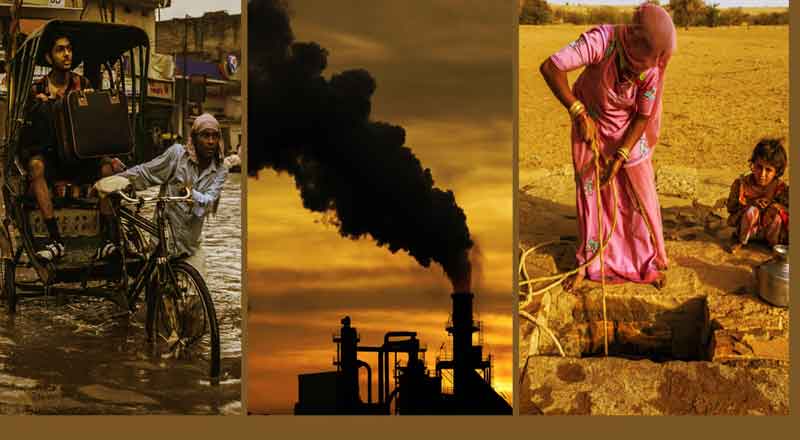A Nation Vulnerable to Climate Change
India is facing a profound challenge, with over 80% of its population exposed to climate-related health risks, according to Dr. Soumya Swaminathan, former chief scientist of the World Health Organization (WHO). Speaking at the COP29 climate talks in Azerbaijan, she emphasized the urgent need for integrated policies addressing health, climate, and gender equity. India’s vast population, diverse geography, and socioeconomic disparities make it particularly susceptible to the multifaceted impacts of climate change, from air pollution to malnutrition and vector-borne diseases.
The Health-Climate Nexus
The effects of climate change on health in India are both immediate and long-term. Key health risks include:
Respiratory and Cardiovascular Diseases: Air pollution remains a major concern, exacerbated by high urban population density and industrial emissions.
Vector-Borne Diseases: Rising temperatures and altered rainfall patterns have expanded the habitats of disease-carrying vectors like mosquitoes.
Malnutrition: Disrupted agricultural cycles due to extreme weather events threaten food security, with cascading effects on nutrition.
Dr. Swaminathan pointed out that women and children, especially in rural areas, bear the brunt of these risks. For example, reliance on solid fuels for cooking exposes women to indoor air pollution, while children face heightened vulnerabilities to malnutrition and infectious diseases.
The Role of Clean Energy and Urban Resilience
One of the most critical solutions lies in transitioning to clean energy. Access to clean cooking fuels can dramatically reduce health risks associated with indoor air pollution while lowering India’s carbon footprint. Similarly, investing in green public transportation offers dual benefits of reducing air pollution and promoting physical activity, which can help curb chronic diseases.
Urban centers are particularly at risk due to population density and infrastructure limitations. Peri-urban areas housing migrants are especially vulnerable during floods and extreme weather events. Swaminathan advocated for climate-resilient infrastructure and improved housing to mitigate these risks.
Gendered Approach to Climate Policy
Dr. Swaminathan stressed the importance of a gendered perspective in climate policy. Women often shoulder a disproportionate burden in rural and poor communities, whether through caregiving roles or direct exposure to health risks. Policies targeting gender equity—such as better access to healthcare, education, and resources—can foster more inclusive and effective climate action.
Research on gender-specific impacts of climate change is urgently needed to design targeted interventions. For instance, empowering women with clean energy solutions and access to healthcare can yield significant improvements in public health outcomes while advancing social equity.
Economic Implications of Climate-Driven Health Impacts
The economic costs of climate-related health issues are staggering. Air pollution alone is estimated to cost the global economy trillions of dollars annually in lost productivity, healthcare expenses, and agricultural losses. In India, these costs are acutely felt in both urban and rural areas.
Dr. Swaminathan highlighted the invisible yet pervasive nature of pollution’s impacts: chronic illnesses, decreased quality of life, and diminished workforce productivity. Addressing these issues is not only a moral imperative but also an economic necessity for a nation striving for growth.
Global Collaboration and Local Solutions
Air pollution, a transboundary issue, demands international cooperation. Dr. Swaminathan emphasized the role of global initiatives like the Our Common Air Commission in standardizing air quality monitoring and addressing super pollutants such as methane and black carbon.
At the same time, localized data and solutions are essential. Accurate regional data on pollution and climate impacts can guide policymakers in crafting tailored interventions. For instance, rural electrification and clean water access can transform vulnerable communities, aligning with both development and climate goals.
Building Resilience for a Sustainable Future
India stands at a critical juncture where climate adaptation and development must go hand in hand. Dr. Swaminathan’s vision for a resilient India includes integrating health and climate objectives, prioritizing gender equity, and leveraging global partnerships to combat transboundary issues like air pollution.
While challenges remain, India has the potential to lead by example in sustainable urbanization, clean energy adoption, and inclusive policymaking. By addressing the health-climate nexus with innovation and equity, India can build a future that is not only sustainable but also just and prosperous.
As Swaminathan aptly concluded, “Development is still a key priority for us, but it must be climate-resilient.” This approach will ensure that the nation’s progress is not derailed by the growing threats of climate change but instead transforms these challenges into opportunities for holistic growth.
(With inputs from agencies)





